Clay-Hosted Lithium Exploration in the Wenshan Region of Southeastern Yunnan Province, China, Using Multi-Source Remote Sensing and Structural Interpretation
Abstract
1. Introduction
2. Overview of the Study Area
2.1. Geographical Location of the Study Area
2.2. Regional Geology
2.2.1. Metallogenic Geological Background
2.2.2. Regional Stratigraphy
2.2.3. Geochemical Characteristics of Lithium in the Wenshan Region
3. Materials and Methods
3.1. Data Sources and Preprocessing
3.1.1. ALOS 12.5 m DEM and Sentinel-2 Data
3.1.2. ASTER Data
3.1.3. ZY1-02D Data
3.2. Technical Methods
3.2.1. Remote Sensing Linear Structural Interpretation
3.2.2. Comprehensive Mineral Identification Based on ASTER Data
3.2.3. Fine Mineral Identification Based on ZY1-02D Data
3.3. Field Survey and Laboratory Analysis
4. Results
4.1. Results of Structural Interpretation
4.2. Results of Comprehensive Mineral Identification Based on ASTER Data
4.2.1. Identification of Iron-Rich Silicate Minerals
4.2.2. Identification of Iron-Rich Magnesium Minerals
4.3. Results of Fine Mineral Identification Based on ZY1-02D Data
4.4. Results of Field Investigation and Laboratory Analysis
4.5. Prospecting Prediction
4.5.1. Analysis of Lithium Occurrences
4.5.2. Prediction of Ore Prospective Areas
5. Discussion
5.1. Remote Sensing Mineral Identification and Lithology Correspondence and Verification Analysis
5.2. Analysis of the Relationship Between Structural Interpretation, Mineral Identification, and Clay-Type Lithium
5.3. Analysis of Prospecting Prediction Results
5.4. Enrichment of Rare Earth Elements
6. Conclusions
7. Patents
Author Contributions
Funding
Data Availability Statement
Acknowledgments
Conflicts of Interest
References
- Ghorbani, Y.; Zhang, S.E.; Bourdeau, J.E.; Chipangamate, N.S.; Rose, D.H.; Valodia, I.; Nwaila, G.T. The Strategic Role of Lithium in the Green Energy Transition: Towards an OPEC-Style Framework for Green Energy-Mineral Exporting Countries (GEMEC). Resour. Policy 2024, 90, 104737. [Google Scholar] [CrossRef]
- Tabelin, C.B.; Dallas, J.; Casanova, S.; Pelech, T.; Bournival, G.; Saydam, S.; Canbulat, I. Towards a Low-Carbon Society: A Review of Lithium Resource Availability, Challenges and Innovations in Mining, Extraction and Recycling, and Future Perspectives. Miner. Eng. 2021, 163, 106743. [Google Scholar] [CrossRef]
- Shi, D.; Zhang, L.; Peng, X.; Li, L.; Song, F.; Nie, F.; Ji, L.; Zhang, Y. Extraction of Lithium from Salt Lake Brine Containing Boron Using Multistage Centrifuge Extractors. Desalination 2018, 441, 44–51. [Google Scholar] [CrossRef]
- Zhang, L.; Li, L.; Shi, D.; Li, J.; Peng, X.; Nie, F. Selective Extraction of Lithium from Alkaline Brine Using HBTA-TOPO Synergistic Extraction System. Sep. Purif. Technol. 2017, 188, 167–173. [Google Scholar] [CrossRef]
- Mohr, S.H.; Mudd, G.M.; Giurco, D. Lithium Resources and Production: Critical Assessment and Global Projections. Minerals 2012, 2, 65–84. [Google Scholar] [CrossRef]
- Wang, W.; Jiang, S.-Y.; Ge, W.; Zhang, Q.; Liu, T.; Zhang, X. Geological Characteristics and Genetic Mechanism of the Lacustrine Sedimentary Clay Type Lithium Deposit. BMPG 2024, 43, 64–78. [Google Scholar] [CrossRef]
- Wang, W.; Jiang, S.-Y.; Zhang, W.-S.; Yin, J. A New Type of Clay-Li Deposit: Fault-Controlled Hydrothermal Alteration in Southern Hubei Province, China. Ore Geol. Rev. 2024, 170, 106138. [Google Scholar] [CrossRef]
- Zhang, J.-Y.; Wang, Q.; Liu, X.-F.; Zhou, G.-F.; Xu, H.-P.; Zhu, Y.-G. Provenance and Ore-Forming Process of Permian Lithium-Rich Bauxite in Central Yunnan, SW China. Ore Geol. Rev. 2022, 145, 104862. [Google Scholar] [CrossRef]
- Cardoso-Fernandes, J.; Silva, J.; Perrotta, M.M.; Lima, A.; Teodoro, A.C.; Ribeiro, M.A.; Dias, F.; Barrès, O.; Cauzid, J.; Roda-Robles, E. Interpretation of the Reflectance Spectra of Lithium (Li) Minerals and Pegmatites: A Case Study for Mineralogical and Lithological Identification in the Fregeneda-Almendra Area. Remote Sens. 2021, 13, 3688. [Google Scholar] [CrossRef]
- Mashkoor, R.; Ahmadi, H.; Rahmani, A.B.; Pekkan, E. Detecting Li-Bearing Pegmatites Using Geospatial Technology: The Case of SW Konar Province, Eastern Afghanistan. Geocarto Int. 2022, 37, 14105–14126. [Google Scholar] [CrossRef]
- Gemusse, U.; Lima, A.; Teodoro, A.C.M. Comparing Different Techniques of Satellite Imagery Classification to Mineral Mapping Pegmatite of Muiane and Naipa: Mozambique. In Proceedings of the Earth Resources and Environmental Remote Sensing/GIS Applications X; Schulz, K., Nikolakopoulos, K.G., Michel, U., Eds.; SPIE: Strasbourg, France, 2019; p. 49. [Google Scholar]
- Benson, T.R.; Coble, M.A.; Dilles, J.H. Hydrothermal Enrichment of Lithium in Intracaldera Illite-Bearing Claystones. Sci. Adv. 2023, 9, eadh8183. [Google Scholar] [CrossRef]
- Li, C.; Li, Z.; Wu, T.; Luo, Y.; Zhao, J.; Li, X.; Yang, W.; Chen, X. Metallogenic Characteristics and Formation Mechanism of Naomugeng Clay-Type Lithium Deposit in Central Inner Mongolia, China. Minerals 2021, 11, 238. [Google Scholar] [CrossRef]
- Castor, S.B.; Henry, C.D. Lithium-Rich Claystone in the McDermitt Caldera, Nevada, USA: Geologic, Mineralogical, and Geochemical Characteristics and Possible Origin. Minerals 2020, 10, 68. [Google Scholar] [CrossRef]
- Wen, H.; Luo, C.; Du, S.; Yu, W.; Gu, H.; Ling, K.; Cui, Y.; Li, Y.; Yang, J. Carbonate-Hosted Clay-Type Lithium Deposit and Its Prospecting Significance. CSB 2020, 65, 53–59. [Google Scholar] [CrossRef]
- Wang, R.; Wang, Q.; Huang, Y.; Yang, S.; Liu, X.; Zhou, Q. Combined Tectonic and Paleogeographic Controls on the Genesis of Bauxite in the Early Carboniferous to Permian Central Yangtze Island. Ore Geol. Rev. 2018, 101, 468–480. [Google Scholar] [CrossRef]
- Wang, T.; Fu, Y.; Chen, P.; Hou, K.; Tang, B.; Luo, P.; Yao, L.; Liu, B.; Long, Z.; Liu, Y.; et al. Detrital Composition and Sedimentary Provenance of Early Carboniferous Al-Bearing Rock Series in Central Guizhou. Ore Geol. Rev. 2023, 156, 105404. [Google Scholar] [CrossRef]
- Yang, J.; Wen, H.; Guo, X.; Luo, C.; Yu, W.; Du, S.; Cui, Y.; Zhao, B. Detrital Zircon U–Pb Ages and Trace Elements Indicate the Provenance of Early Carboniferous Li-Rich Claystone from Central Guizhou, South China. Sediment. Geol. 2022, 442, 106278. [Google Scholar] [CrossRef]
- Zhang, G.; Zhao, Z.; Zhang, X.; Wu, X.; Zheng, Y.; Feng, L.; Huang, Z. Comprehensive Multi-Source Remote Sensing Data Integration for Enhanced Mineralization Alteration Extraction and Geological Structure Interpretation in the Lala Region of Sichuan Province. Ore Geol. Rev. 2024, 168, 106032. [Google Scholar] [CrossRef]
- Zhang, X.; Zhao, Z.; Chen, Q.; Chai, W.; Li, Z.; Zhang, G.; Yang, H.; Niu, L. Mapping Hydrothermal Alteration of the Pulang Porphyry Copper Deposit, SW China, Using ASTER and ZY1-02D Satellite Data. Ore Geol. Rev. 2023, 161, 105605. [Google Scholar] [CrossRef]
- Ren, Z.; Sun, L.; Zhai, Q. Improved K-Means and Spectral Matching for Hyperspectral Mineral Mapping. Int. J. Appl. Earth Obs. Geoinf. 2020, 91, 102154. [Google Scholar] [CrossRef]
- Chen, L.; Zhang, N.; Zhao, T.; Zhang, H.; Chang, J.; Tao, J.; Chi, Y. Lithium-Bearing Pegmatite Identification, Based on Spectral Analysis and Machine Learning: A Case Study of the Dahongliutan Area, NW China. Remote Sens. 2023, 15, 493. [Google Scholar] [CrossRef]
- Chen, L.; Sui, X.; Liu, R.; Chen, H.; Li, Y.; Zhang, X.; Chen, H. Mapping Alteration Minerals Using ZY-1 02D Hyperspectral Remote Sensing Data in Coalbed Methane Enrichment Areas. Remote Sens. 2023, 15, 3590. [Google Scholar] [CrossRef]
- Feng, Y.; Dai, J.; Bai, L.; Wu, C. Prospecting Prediction for the Yulong Metallogenic Belt in Tibet Based on Remote Sensing Alteration Information and Structural Interpretation. Remote Sens. 2024, 16, 1343. [Google Scholar] [CrossRef]
- Shebl, A.; Badawi, M.; Dawoud, M.; Abd El-Wahed, M.; El-Dokouny, H.A.; Csámer, Á. Novel Comprehensions of Lithological and Structural Features Gleaned via Sentinel 2 Texture Analysis. Ore Geol. Rev. 2024, 168, 106068. [Google Scholar] [CrossRef]
- Luo, J.-X.; He, Y.-B.; Wang, R.; Liu, M.; Hu, X.-F. Lithofacies Palaeogeography of the Late Permian Wujiaping Age in the Middle and Upper Yangtze Region, China. J. Palaeogeogr. 2014, 3, 384–409. [Google Scholar] [CrossRef]
- Yue, W.; Yugan, J. Permian Palaeogeographic Evolution of the Jiangnan Basin, South China. Palaeogeogr. Palaeoclimatol. Palaeoecol. 2000, 160, 35–44. [Google Scholar] [CrossRef]
- Wen, H.J.; Luo, C.G.; Du, S.J.; Yu, X.W.; Ling, K.Y.; Li, Y.; Yang, J.H. Carbonate Hosted Clay-Type Lithium Deposit and Its Prospecting Significance. Chin. Sci. Bul. 2020, 65, 53–59. (In Chinese) [Google Scholar] [CrossRef]
- Lei, Y. Genesis and Metallogenic Regularity of Late Permiansedimentary Bauxite Deposit, Southeast Yunnan. Ph.D. Thesis, China University of Geosciences, Beijing, China, 2012. [Google Scholar]
- Liu, X.; Zhao, L.; Wang, Q.; Sun, X.; Liu, L.; Yang, S.; Deng, J. Provenance and Genesis of Karstic Bauxite Deposits in China: Implications for the Formation of Super-Large Karstic Bauxite Deposits. Earth Sci. Rev. 2024, 257, 104882. [Google Scholar] [CrossRef]
- He, B.; Xu, Y.-G.; Chung, S.-L.; Xiao, L.; Wang, Y. Sedimentary Evidence for a Rapid, Kilometer-Scale Crustal Doming Prior to the Eruption of the Emeishan Flood Basalts. Earth Planet. Sci. Lett. 2003, 213, 391–405. [Google Scholar] [CrossRef]
- Zhang, L.; Park, C.; Wang, G.; Wu, C.; Santosh, M.; Chung, D.; Song, Y. Phase Transformation Processes in Karst-Type Bauxite Deposit from Yunnan Area, China. Ore Geol. Rev. 2017, 89, 407–420. [Google Scholar] [CrossRef]
- Chen, Y.; Yang, G.; Li, K. Atlas of Geophysics and Geochemistry of Yunnan Province; Xie, K., Ed.; Geological Publishing House: Beijing, China, 2015; ISBN 978-7-116-09294-5. [Google Scholar]
- Lehmann, J.; Brower, A.M.; Owen-Smith, T.M.; Bybee, G.M.; Hayes, B. Landsat 8 and Alos DEM Geological Mapping Reveals the Architecture of the Giant Mesoproterozoic Kunene Complex Anorthosite Suite (Angola/Namibia). Geosci. Front. 2023, 14, 101620. [Google Scholar] [CrossRef]
- Fatdillah, E.; Rehan, B.M.; Rameshwaran, P.; Bell, V.A.; Zulkafli, Z.; Yusuf, B.; Sayers, P. Spatial Estimates of Flood Damage and Risk Are Influenced by the Underpinning DEM Resolution: A Case Study in Kuala Lumpur, Malaysia. Water 2022, 14, 2208. [Google Scholar] [CrossRef]
- Mandanici, E.; Bitelli, G. Preliminary Comparison of Sentinel-2 and Landsat 8 Imagery for a Combined Use. Remote Sens. 2016, 8, 1014. [Google Scholar] [CrossRef]
- Sekandari, M.; Masoumi, I.; Beiranvand Pour, A.; M Muslim, A.; Rahmani, O.; Hashim, M.; Zoheir, B.; Pradhan, B.; Misra, A.; Aminpour, S.M. Application of Landsat-8, Sentinel-2, ASTER and WorldView-3 Spectral Imagery for Exploration of Carbonate-Hosted Pb-Zn Deposits in the Central Iranian Terrane (CIT). Remote Sens. 2020, 12, 1239. [Google Scholar] [CrossRef]
- Ahmadirouhani, R.; Karimpour, M.-H.; Rahimi, B.; Malekzadeh-Shafaroudi, A.; Pour, A.B.; Pradhan, B. Integration of SPOT-5 and ASTER Satellite Data for Structural Tracing and Hydrothermal Alteration Mineral Mapping: Implications for Cu–Au Prospecting. Int. J. Image Data Fusion 2018, 9, 237–262. [Google Scholar] [CrossRef]
- Mahanta, P.; Maiti, S. Regional Scale Demarcation of Alteration Zone Using ASTER Imageries in South Purulia Shear Zone, East India: Implication for Mineral Exploration in Vegetated Regions. Ore Geol. Rev. 2018, 102, 846–861. [Google Scholar] [CrossRef]
- Rowan, L.C.; Mars, J.C. Lithologic Mapping in the Mountain Pass, California Area Using Advanced Spaceborne Thermal Emission and Reflection Radiometer (ASTER) Data. Remote Sens. Environ. 2003, 84, 350–366. [Google Scholar] [CrossRef]
- Rowan, L.C.; Mars, J.C.; Simpson, C.J. Lithologic Mapping of the Mordor, NT, Australia Ultramafic Complex by Using the Advanced Spaceborne Thermal Emission and Reflection Radiometer (ASTER). Remote Sens. Environ. 2005, 99, 105–126. [Google Scholar] [CrossRef]
- Xiao, D.; Le, B.T.; Ha, T.T.L. Iron Ore Identification Method Using Reflectance Spectrometer and a Deep Neural Network Framework. Spectrochim. Acta Part A Mol. Biomol. Spectrosc. 2021, 248, 119168. [Google Scholar] [CrossRef]
- Safari, M.; Maghsoudi, A.; Pour, A.B. Application of Landsat-8 and ASTER Satellite Remote Sensing Data for Porphyry Copper Exploration: A Case Study from Shahr-e-Babak, Kerman, South of Iran. Geocarto Int. 2018, 33, 1186–1201. [Google Scholar] [CrossRef]
- Sun, W.; Liu, K.; Ren, G.; Liu, W.; Yang, G.; Meng, X.; Peng, J. A Simple and Effective Spectral-Spatial Method for Mapping Large-Scale Coastal Wetlands Using China ZY1-02D Satellite Hyperspectral Images. Int. J. Appl. Earth Obs. Geoinf. 2021, 104, 102572. [Google Scholar] [CrossRef]
- Guo, H.; Zhang, R.; Dai, W.; Zhou, X.; Zhang, D.; Yang, Y.; Cui, J. Mapping Soil Organic Matter Content Based on Feature Band Selection with ZY1-02D Hyperspectral Satellite Data in the Agricultural Region. Agronomy 2022, 12, 2111. [Google Scholar] [CrossRef]
- Lu, H.; Qiao, D.; Li, Y.; Wu, S.; Deng, L. Fusion of China ZY-1 02D Hyperspectral Data and Multispectral Data: Which Methods Should Be Used? Remote Sens. 2021, 13, 2354. [Google Scholar] [CrossRef]
- Qi, C.W.; Dong, J.E.; Chen, X.; Ye, G.F.; He, S.Y.; Dai, W.; Wang, B. Application of Altered Mineral Mapping and Mineral Exploration by Using ZY-1 02D Hyperspectral Data in Northern Desert Area of Qaidam Basin. Remote Sens. Nat. Resour. 2024, 1–12. [Google Scholar] [CrossRef]
- Zhang, R.S.; Cao, H.; Zeng, M.; Zhang, D.X.; Li, G.X. Scientific Belt Lithologic Mapping Based on ASTER Spectral Analysis: A Case Study from the Tashkorgan Area (Xinjiang, China). Acta Petrol. Sin. 2016, 32, 3835–3846. [Google Scholar]
- Ninomiya, Y.; Fu, B.; Cudahy, T.J. Detecting Lithology with Advanced Spaceborne Thermal Emission and Reflection Radiometer (ASTER) Multispectral Thermal Infrared “Radiance-at-Sensor” Data. Remote Sens. Environ. 2005, 99, 127–139. [Google Scholar] [CrossRef]
- Guha, S.; Govil, H. Evaluation of ASTER TIR Data-Based Lithological Indices in Malanjkhand Copper Mines of Madhya Pradesh, India. Appl. Earth Sci. 2020, 129, 3–8. [Google Scholar] [CrossRef]
- Ding, W.; Ding, L.; Li, Q.; Li, J.; Zhang, L. Lithium-Rich Pegmatite Detection Integrating High-Resolution and Hyperspectral Satellite Data in Zhawulong Area, Western Sichuan, China. Remote Sens. 2023, 15, 3969. [Google Scholar] [CrossRef]
- Petropoulos, G.P.; Vadrevu, K.P.; Kalaitzidis, C. Spectral Angle Mapper and Object-Based Classification Combined with Hyperspectral Remote Sensing Imagery for Obtaining Land Use/Cover Mapping in a Mediterranean Region. Geocarto Int. 2013, 28, 114–129. [Google Scholar] [CrossRef]
- Tripathi, M.K.; Govil, H.; Diwan, P. Comparative Evaluation Threshold Parameters of Spectral Angle Mapper (SAM) for Mapping of Chhabadiya Talc Minerals, Jahajpur, Bhilwara, India Using Hyperion Hyperspectral Remote Sensing Data. In Proceedings of the 2019 2nd International Conference on Intelligent Communication and Computational Techniques (ICCT), Jaipur, India, 28–29 September 2019; pp. 70–74. [Google Scholar]
- Kruse, F.A.; Lefkoff, A.B.; Heidebrecht, K.B. The Spectral Image Processing System (Sips)—Software For Integrated Analysis Of Aviris Data. In Proceedings of the Third Annual JPL Airborne Geoscience Workshop. Volume 1: AVIRIS Workshop, Pasadena, CA, USA, 1–5 June 1992. [Google Scholar]
- Warr, L.N. IMA–CNMNC Approved Mineral Symbols. Mineral. Mag. 2021, 85, 291–320. [Google Scholar] [CrossRef]
- Palumbo, B.; Bellanca, A.; Neri, R.; Roe, M.J. Trace Metal Partitioning in Fe–Mn Nodules from Sicilian Soils, Italy. Chem. Geol. 2001, 173, 257–269. [Google Scholar] [CrossRef]
- Gao, T.; Ke, S.; Wang, S.-J.; Li, F.; Liu, C.; Lei, J.; Liao, C.; Wu, F. Contrasting Mg Isotopic Compositions between Fe-Mn Nodules and Surrounding Soils: Accumulation of Light Mg Isotopes by Mg-Depleted Clay Minerals and Fe Oxides. Geochim. Et Cosmochim. Acta 2018, 237, 205–222. [Google Scholar] [CrossRef]
- Ilgen, A.G.; Kukkadapu, R.K.; Leung, K.; Washington, R.E. “Switching on” Iron in Clay Minerals. Environ. Sci. Nano 2019, 6, 1704–1715. [Google Scholar] [CrossRef]
- Tipper, E.T.; Calmels, D.; Gaillardet, J.; Louvat, P.; Capmas, F.; Dubacq, B. Positive Correlation between Li and Mg Isotope Ratios in the River Waters of the Mackenzie Basin Challenges the Interpretation of Apparent Isotopic Fractionation during Weathering. Earth Planet. Sci. Lett. 2012, 333–334, 35–45. [Google Scholar] [CrossRef]
- Wimpenny, J.; Colla, C.A.; Yin, Q.-Z.; Rustad, J.R.; Casey, W.H. Investigating the Behaviour of Mg Isotopes during the Formation of Clay Minerals. Geochim. Et Cosmochim. Acta 2014, 128, 178–194. [Google Scholar] [CrossRef]
- Ling, K.; Wen, H.; Zhang, Q.; Luo, C.; Gu, H.; Du, S.; Yu, W. Super-Enrichment of Lithium and Niobium in the Upper Permian Heshan Formation in Pingguo, Guangxi, China. Sci. China Earth Sci. 2021, 64, 753–772. [Google Scholar] [CrossRef]
- He, B.; Xu, Y.-G.; Huang, X.-L.; Luo, Z.-Y.; Shi, Y.-R.; Yang, Q.-J.; Yu, S.-Y. Age and Duration of the Emeishan Flood Volcanism, SW China: Geochemistry and SHRIMP Zircon U–Pb Dating of Silicic Ignimbrites, Post-Volcanic Xuanwei Formation and Clay Tuff at the Chaotian Section. Earth Planet. Sci. Lett. 2007, 255, 306–323. [Google Scholar] [CrossRef]
- Xu, Y.; Zheng, L.; Yang, Z.; Tong, Y.-B.; Wang, B.; Yuan, W.; Jing, X. Rapid Eruption of the Emeishan Continental Flood Basalts: New Paleomagnetic and Geochronologic Constraints. GSA Bull. 2021, 134, 1845–1862. [Google Scholar] [CrossRef]
- Ling, K.-Y.; Tang, H.-S.; Zhang, Z.-W.; Wen, H.-J. Host Minerals of Li–Ga–V–Rare Earth Elements in Carboniferous Karstic Bauxites in Southwest China. Ore Geol. Rev. 2020, 119, 103325. [Google Scholar] [CrossRef]
- Feng, X.; Onel, O.; Council-Troche, M.; Noble, A.; Yoon, R.-H.; Morris, J.R. A Study of Rare Earth Ion-Adsorption Clays: The Speciation of Rare Earth Elements on Kaolinite at Basic pH. Appl. Clay Sci. 2021, 201, 105920. [Google Scholar] [CrossRef]
- Xiao, Y.; Huang, L.; Long, Z.; Feng, Z.; Wang, L. Adsorption Ability of Rare Earth Elements on Clay Minerals and Its Practical Performance. J. Rare Earths 2016, 34, 543–548. [Google Scholar] [CrossRef]
- Hugo, R.C.; Hoagland, R.G. Gallium Penetration of Aluminum: In-Situ TEM Observations at the Penetration Front. Scr. Mater. 1999, 41, 1341–1346. [Google Scholar] [CrossRef]

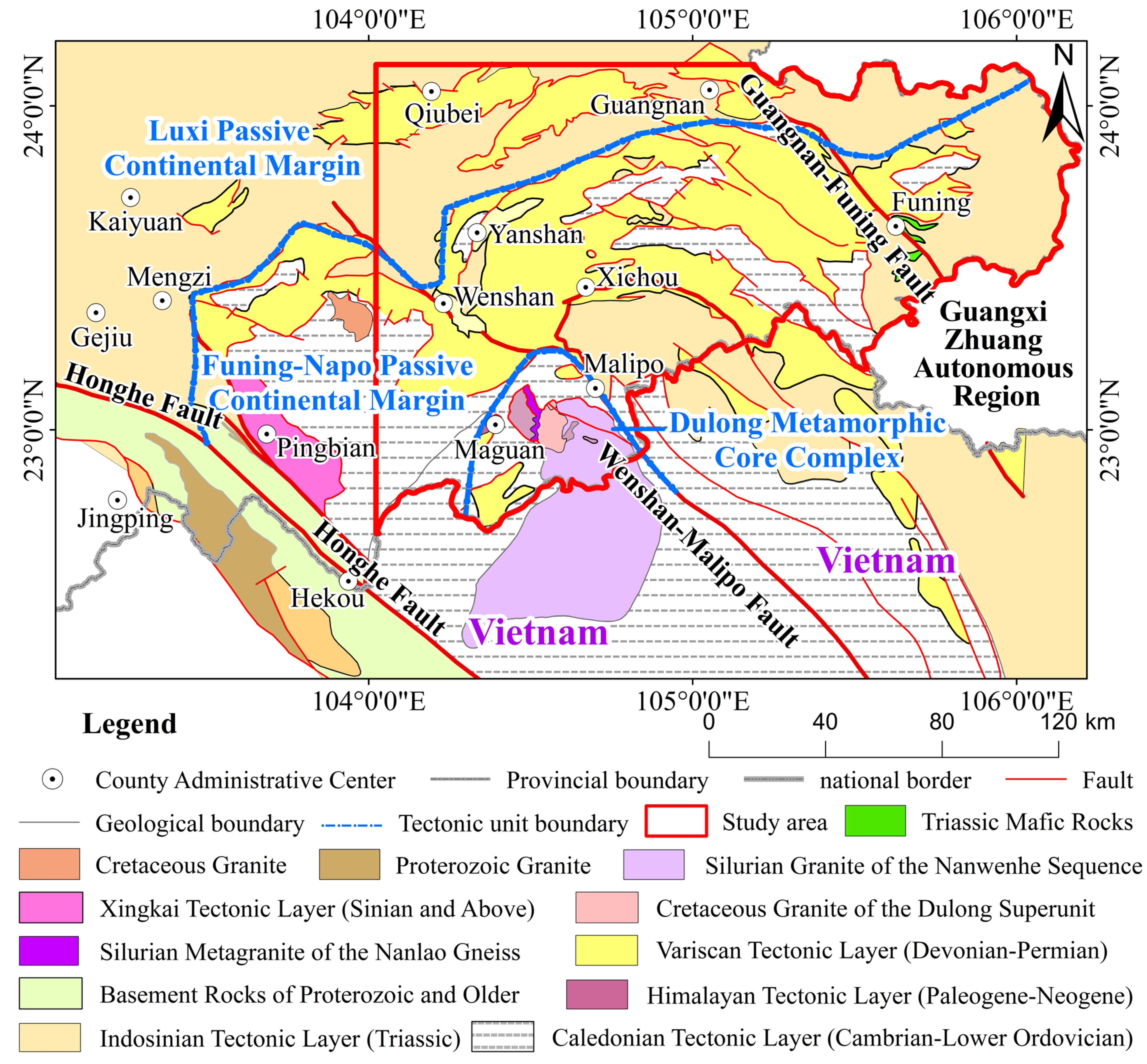
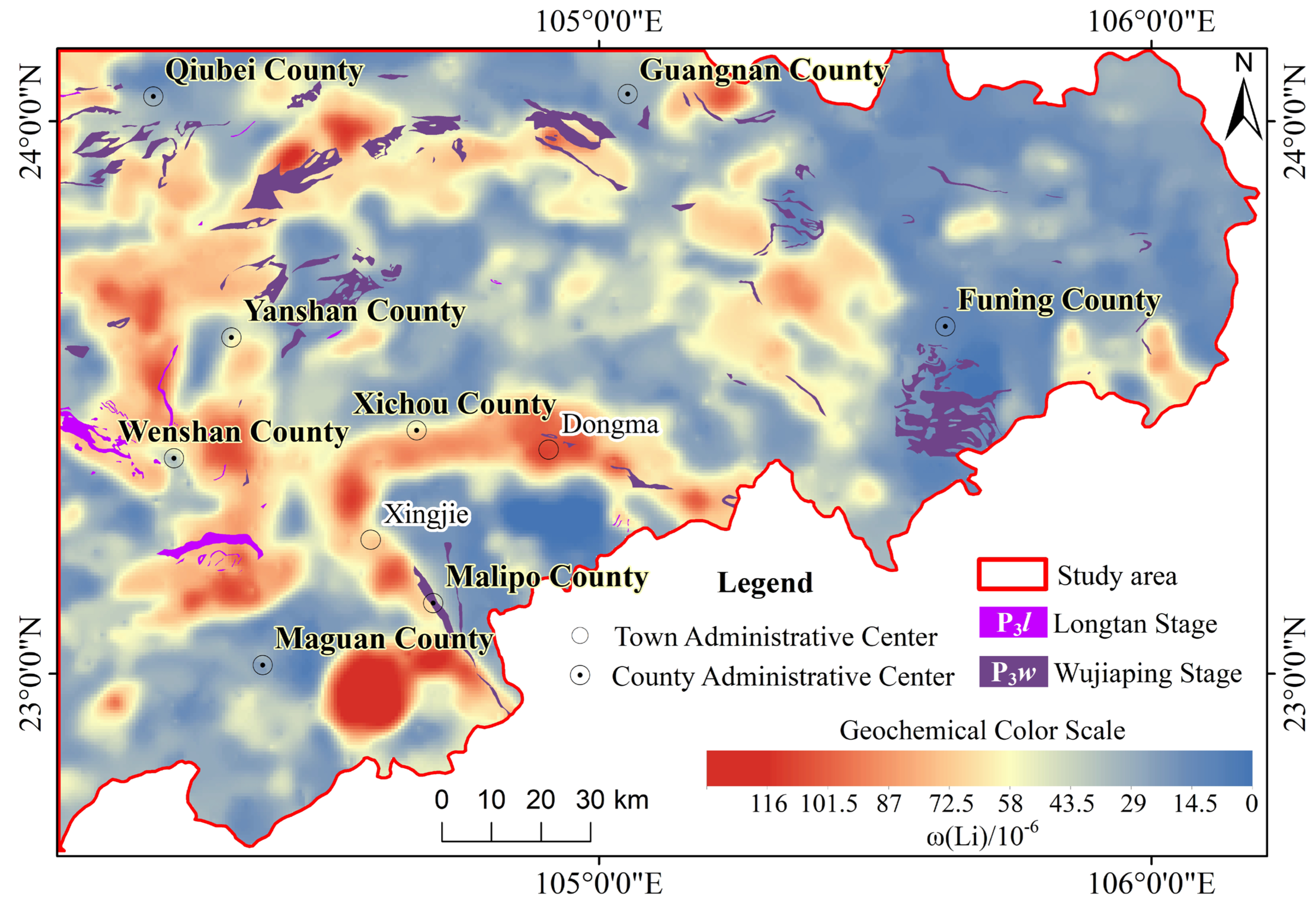

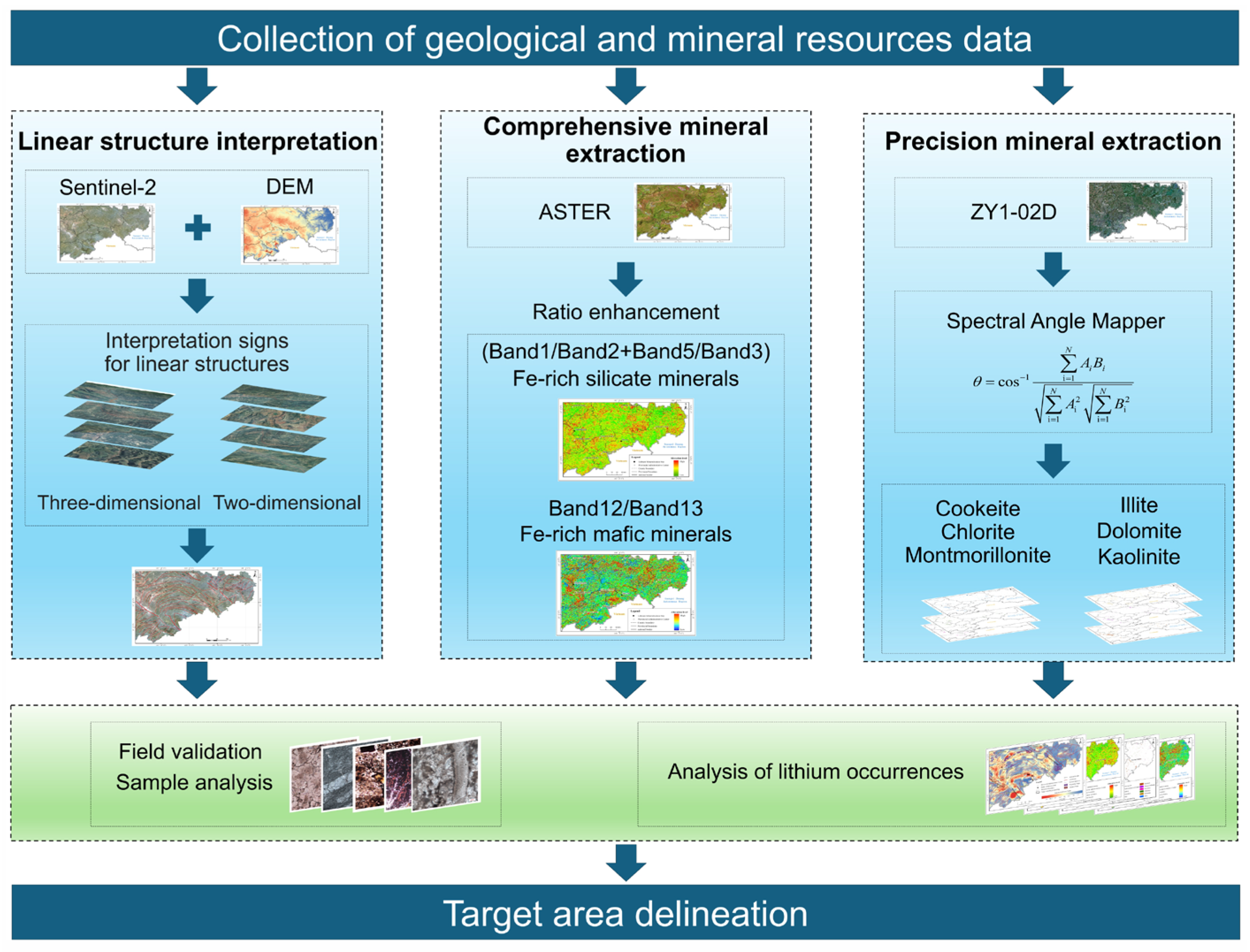
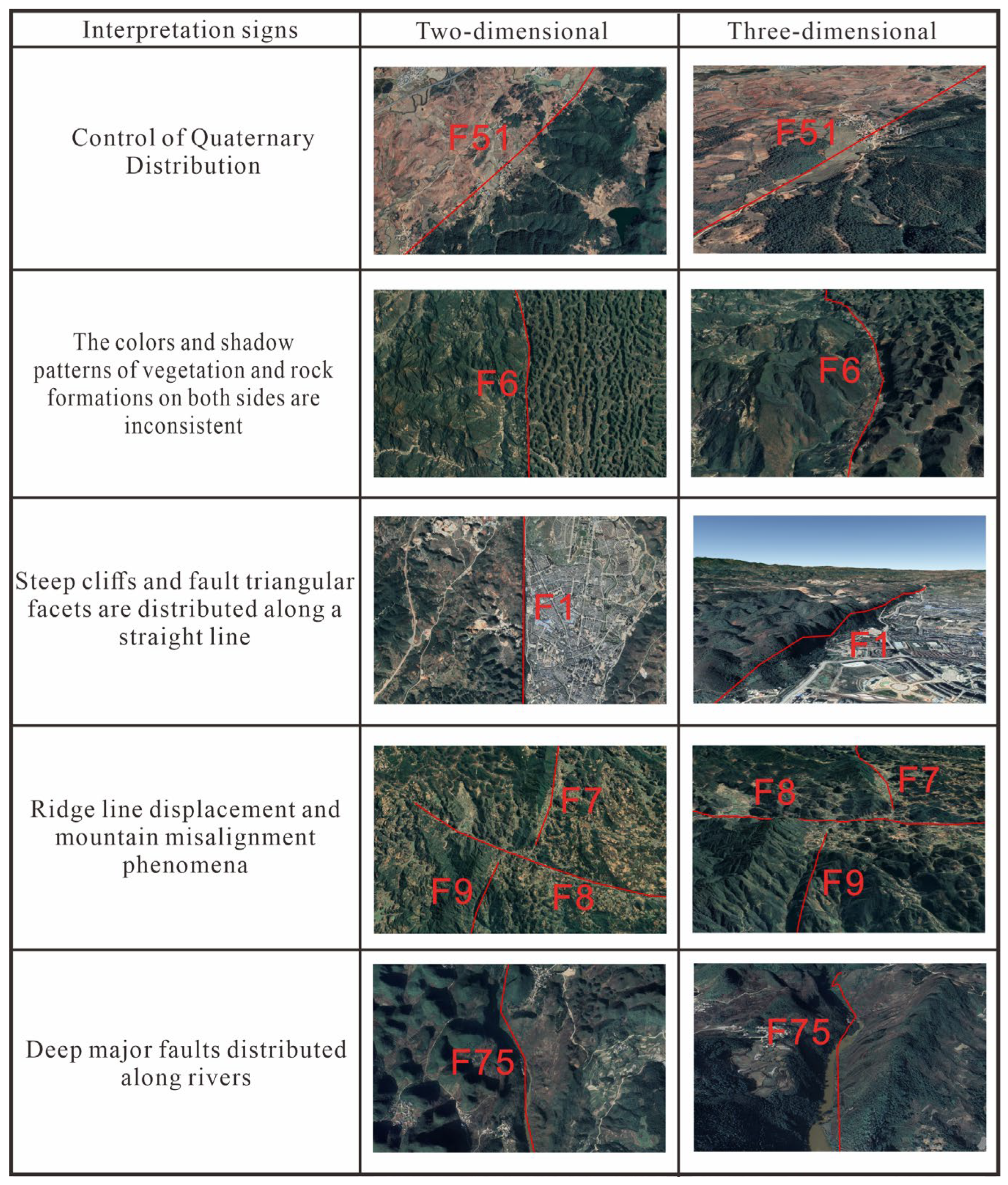
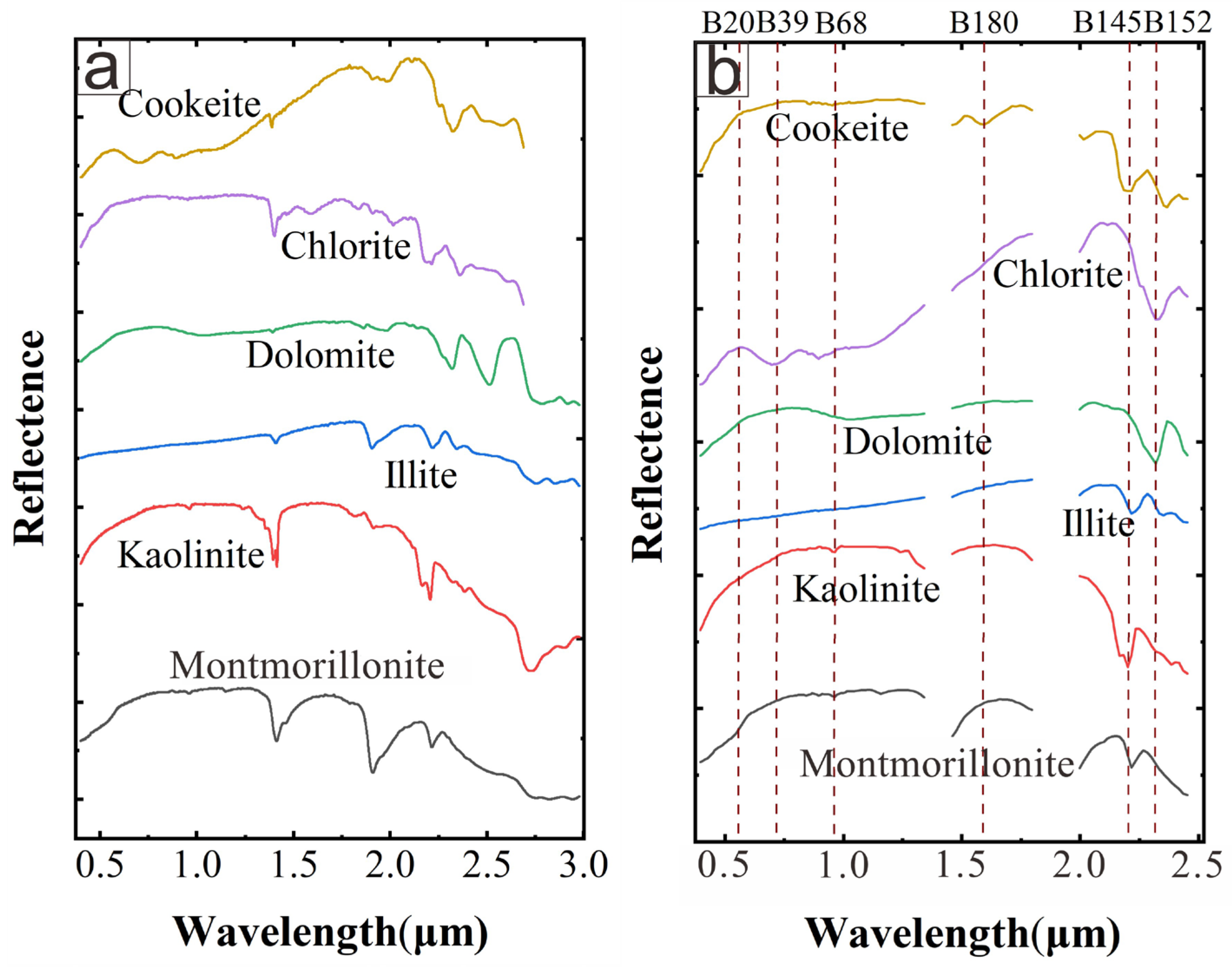
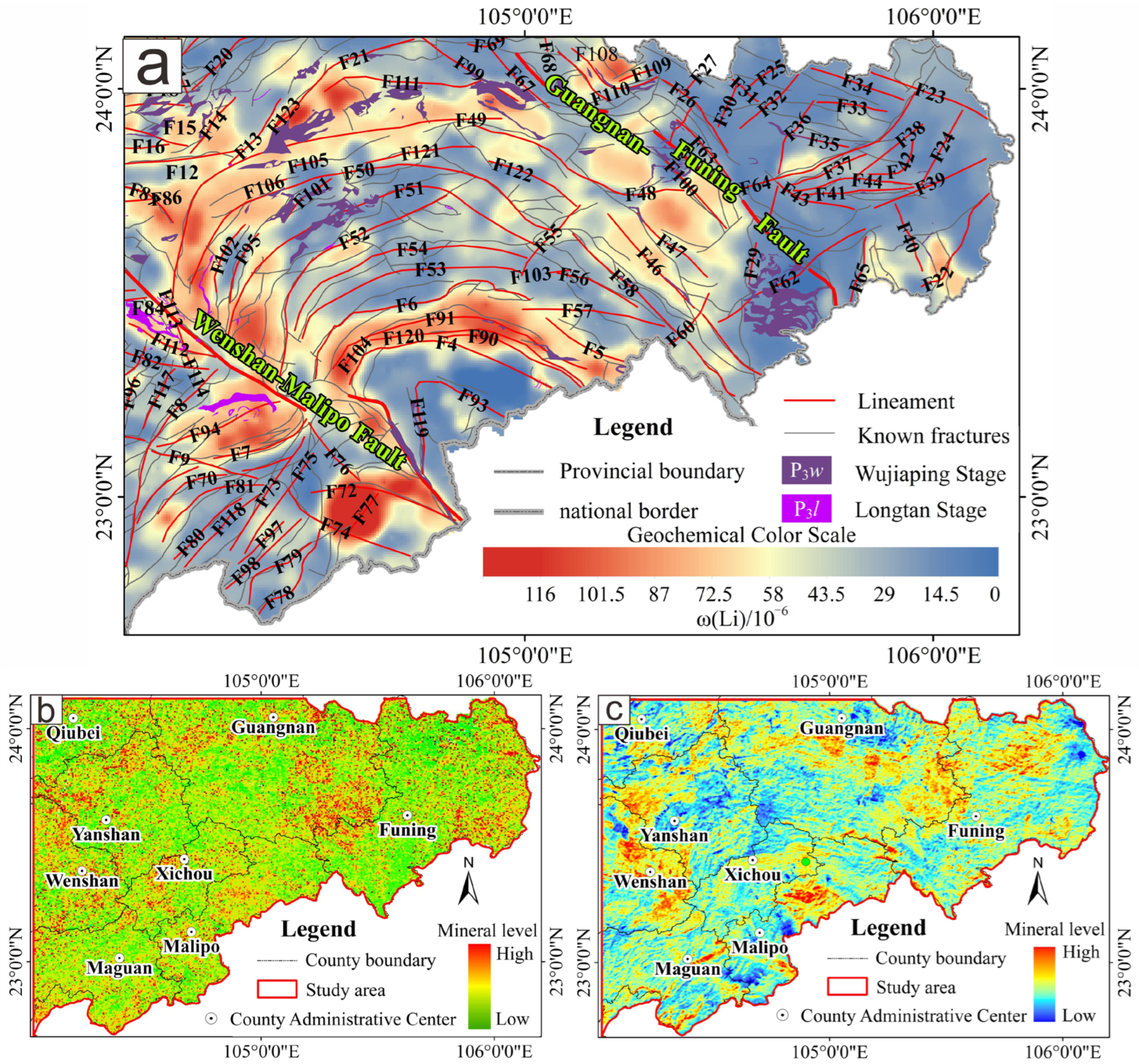
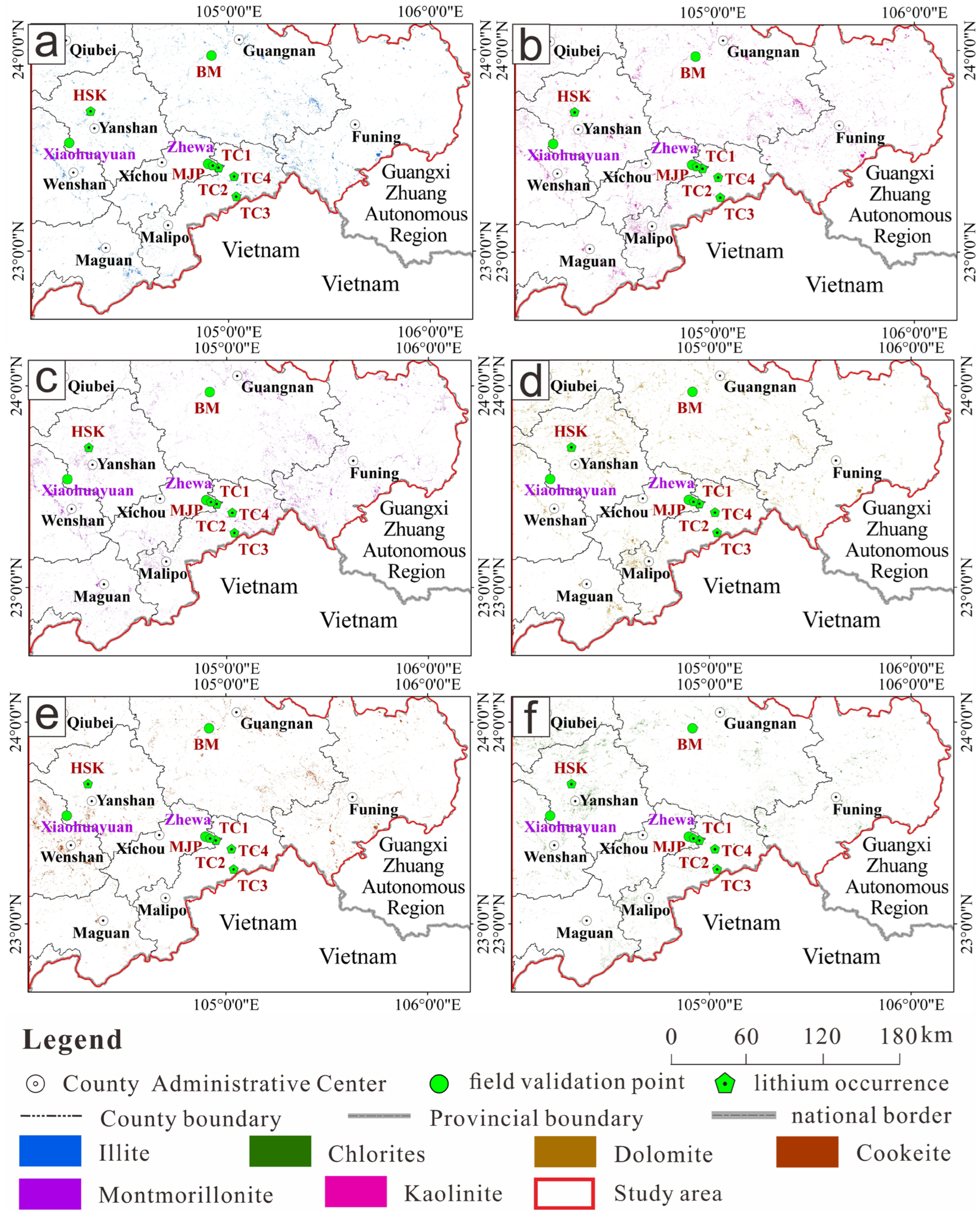
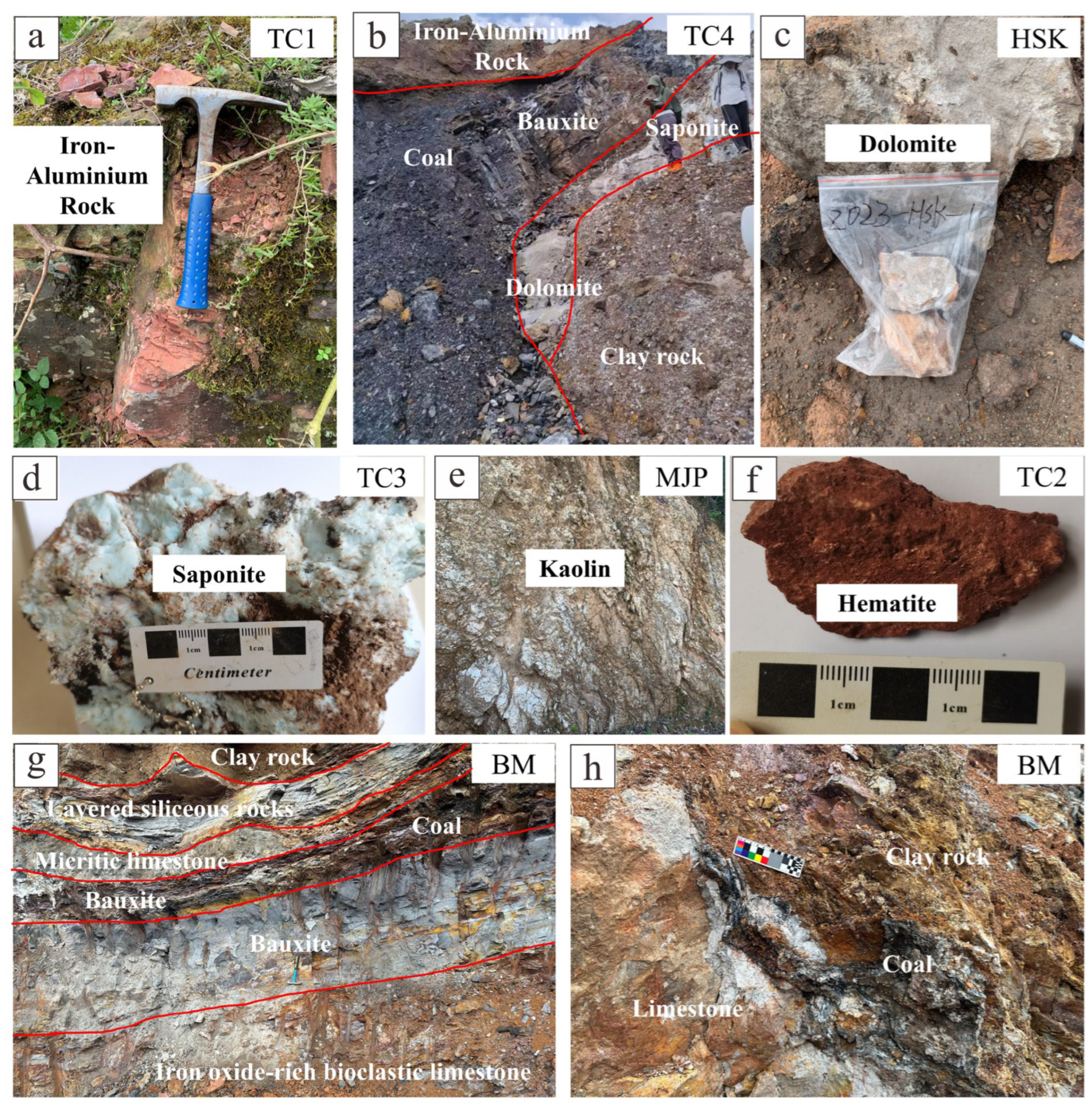

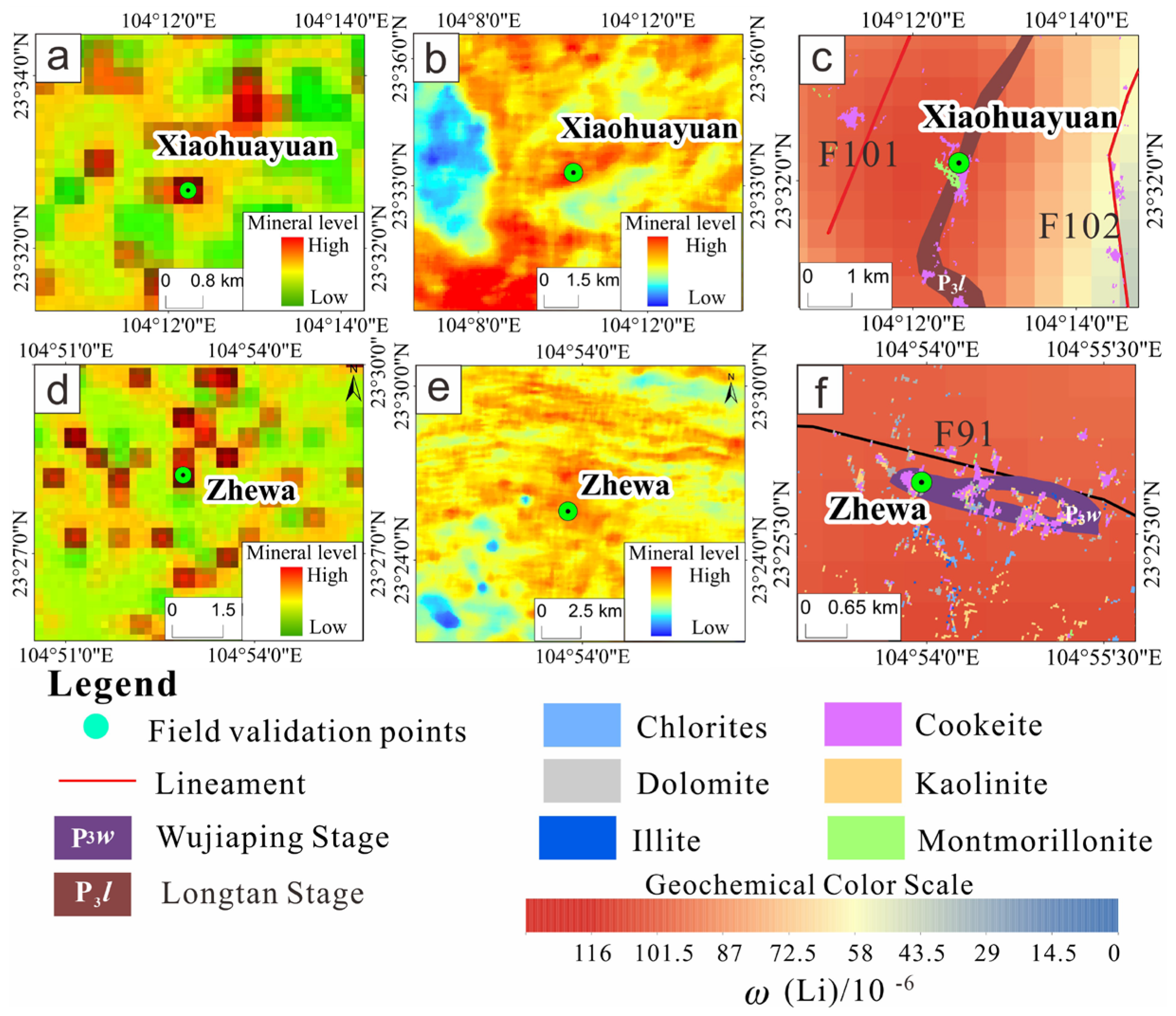


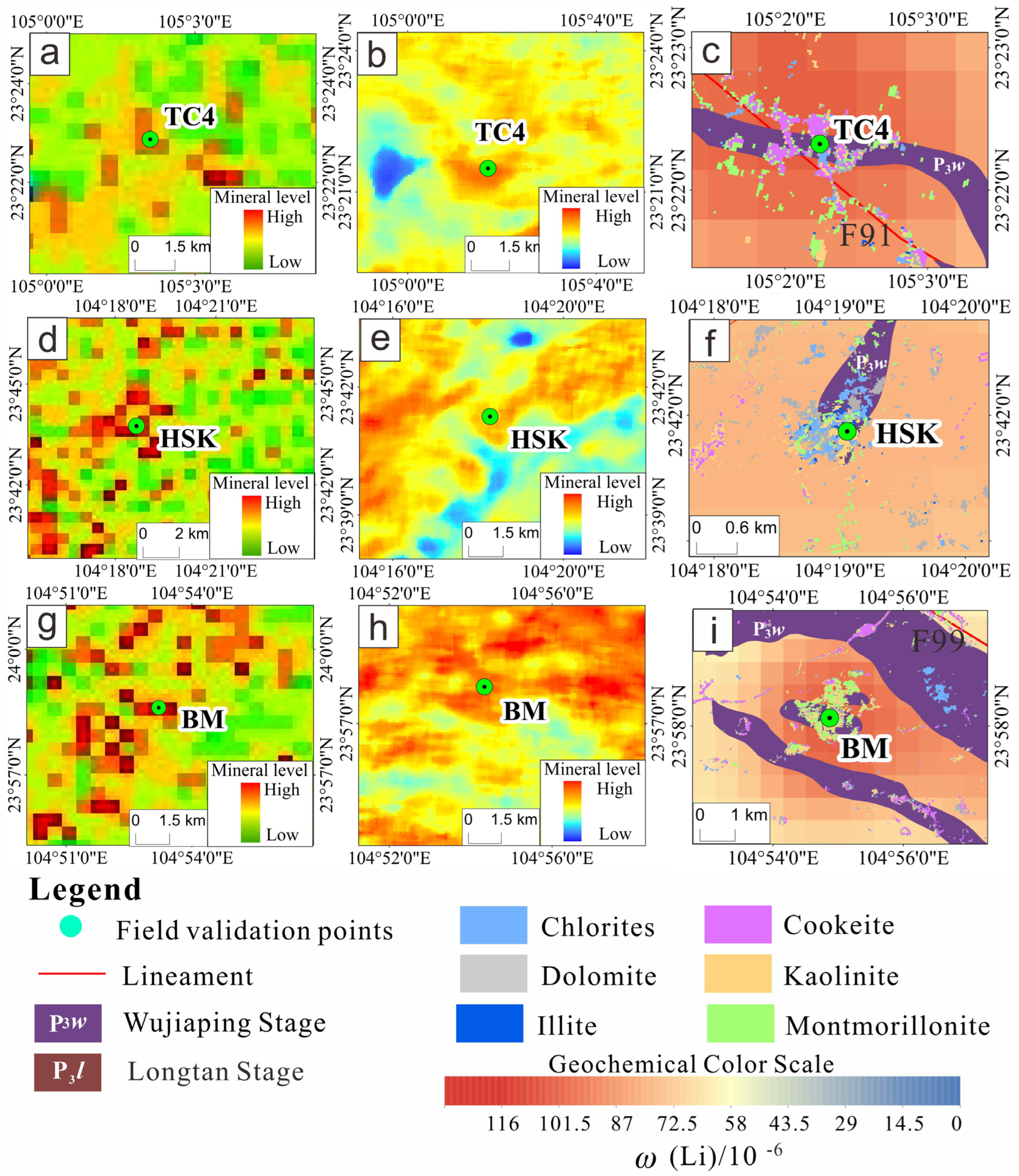
| Item | Sentinel-2 |
|---|---|
| Launch date | sentinel-2A 23 June 2015 sentinel-2B 7 March 2017 |
| Nominal equatorial crossing time | 10:30 a.m. |
| altitude | sun-synchronous orbit (786 km) |
| Ultra | 443 nm (60 m) |
| Swath/field of view | 290 km/20.6 |
| Visible | 490 nm (10 m), 560 nm (10 m), 665 nm (10 m) |
| Red | 705 nm (20 m), 740 nm (20 m), 783 nm (20 m) |
| NIR | 842 nm (10 m), 865 nm (20 m) |
| SWIR | 1610 nm (20 m), 2190 nm (20 m) |
| Cirrus | 1375 nm (60 m) |
| Water vapor | 945 nm (60 m) |
| Item | EmptyCell | Terra(ASTER) | ZY1-02D(AHSI) |
|---|---|---|---|
| Spectral range | VL/NIR | 0.556 μm | 0.396 μm–1.04 μm (b1–b76) |
| 0.661 μm | |||
| 0.807 μm | |||
| SWIR | 1.656 μm | 1.005 μm–2.501 μm (b77–b166) | |
| 2.167 μm | |||
| 2.209 μm | |||
| 2.262 μm | |||
| 2.336 μm | |||
| 2.4 μm | |||
| TIR | 8.291 μm | Null | |
| 8.634 μm | |||
| 9.075 μm | |||
| 10.657 μm | |||
| 11.318 μm | |||
| Spatial resolution | VL/NIR | 10 m | 30 m |
| SWIR | 30 m | ||
| TIR | 90 m | ||
| Spectral resolution | VL/NIR | Null | 10 nm |
| SWIR | 20 nm | ||
| TIR | Null |
| Sample/Statistic | Al, % | Fe, % | Li, μg/g | Mg, % | Al2O3, % | TFe2O3, % | MgO, % |
|---|---|---|---|---|---|---|---|
| TC4 minimum | 0.01 | 0.02 | 7.30 | 0.01 | 0.04 | 0.05 | 0.02 |
| TC4 maximum | 17.00 | 16.05 | 2590.00 | 8.13 | 65.11 | 23.13 | 1.82 |
| TC4 mean value | 8.91 | 4.20 | 229.43 | 0.97 | 34.36 | 8.29 | 0.43 |
| HSK minimum | 0.08 | 0.06 | 0.20 | 0.01 | 0.04 | 0.31 | 0.02 |
| HSK mean value | 19.45 | 36.00 | 1050.00 | 1.00 | 69.21 | 54.63 | 0.51 |
| HSK mean value | 11.56 | 16.07 | 326.85 | 0.32 | 40.88 | 23.86 | 0.26 |
| BM minimum | — | — | 9.12 | — | 0.56 | 0.30 | — |
| BM maximum | — | — | 1739.00 | — | 62.91 | 27.22 | — |
| BM mean value | — | — | 775.08 | — | 34.33 | 11.47 | — |
Disclaimer/Publisher’s Note: The statements, opinions and data contained in all publications are solely those of the individual author(s) and contributor(s) and not of MDPI and/or the editor(s). MDPI and/or the editor(s) disclaim responsibility for any injury to people or property resulting from any ideas, methods, instructions or products referred to in the content. |
© 2025 by the authors. Licensee MDPI, Basel, Switzerland. This article is an open access article distributed under the terms and conditions of the Creative Commons Attribution (CC BY) license (https://creativecommons.org/licenses/by/4.0/).
Share and Cite
Feng, L.; Zhao, Z.; Yang, H.; Chen, Q.; Yang, C.; Zhao, X.; Zhang, G.; Zhang, X.; Dong, X. Clay-Hosted Lithium Exploration in the Wenshan Region of Southeastern Yunnan Province, China, Using Multi-Source Remote Sensing and Structural Interpretation. Minerals 2025, 15, 826. https://doi.org/10.3390/min15080826
Feng L, Zhao Z, Yang H, Chen Q, Yang C, Zhao X, Zhang G, Zhang X, Dong X. Clay-Hosted Lithium Exploration in the Wenshan Region of Southeastern Yunnan Province, China, Using Multi-Source Remote Sensing and Structural Interpretation. Minerals. 2025; 15(8):826. https://doi.org/10.3390/min15080826
Chicago/Turabian StyleFeng, Lunxin, Zhifang Zhao, Haiying Yang, Qi Chen, Changbi Yang, Xiao Zhao, Geng Zhang, Xinle Zhang, and Xin Dong. 2025. "Clay-Hosted Lithium Exploration in the Wenshan Region of Southeastern Yunnan Province, China, Using Multi-Source Remote Sensing and Structural Interpretation" Minerals 15, no. 8: 826. https://doi.org/10.3390/min15080826
APA StyleFeng, L., Zhao, Z., Yang, H., Chen, Q., Yang, C., Zhao, X., Zhang, G., Zhang, X., & Dong, X. (2025). Clay-Hosted Lithium Exploration in the Wenshan Region of Southeastern Yunnan Province, China, Using Multi-Source Remote Sensing and Structural Interpretation. Minerals, 15(8), 826. https://doi.org/10.3390/min15080826






